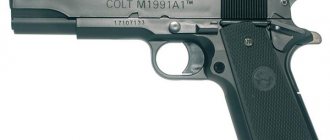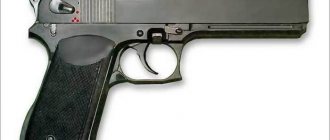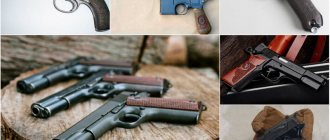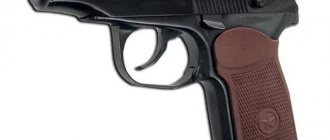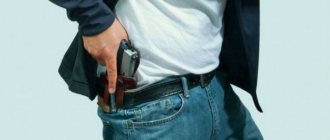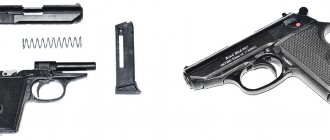After the end of World War II, Czechoslovakia did not have its own small arms development. The army and police used Soviet TT models and German trophies. This could not continue for long and the country's leadership came to the decision to begin its own development. Of all the variety of modern modifications of pistols, the CZ 75 Tactical model is in particular demand among those who understand.
In the ranking of this type of weapon, it is located next to the Colt M 1911 and Beretta 92, which have been recognized as the standard for many years and are used to design others.
History of creation
The CZ pistol was designed in Czechoslovakia in 1975. Two brothers worked on its project: Josef and Frantisek Koucki from the city of Uherský Brod. They worked by order of the country's armed forces, at the Czech Zbroevka enterprise.
Previously, the model was being prepared for export and was being prepared as a replacement for the heavy and bulky Parabellum, which was used by the police and military. The first modifications had a similar caliber and ammunition size. As a result of modifications, the model was adapted for the use of cartridges with greater power: .40 S2W and 9*21 IMI.
The first official display took place in 1976 in Madrid, at an arms exhibition. The project was assigned the index CZ-75 SP, which was deciphered quite simply: from the name of the trademark of the Czechoslovak plant where the weapon was developed.
A year later, the Cheset was put into mass production, but in its homeland it could not gain full recognition, since it was fired using cartridges that were not in service at that time. The only Czech security forces who use this pistol are the special services of the Department of Internal Affairs, who valued the CZ pistol in many ways superior to the Makarov and Tula Tokarev.
Subsequently, the production license was sold to the Italians and Swiss. A few more years later, the Czech pistol began to be assembled in America, Turkey and Israel.
In addition, the weapon became the prototype for many models developed on its basis by other countries, including not only combat types, but also those intended for training (CZ 75 Standard IPSC) and pneumatic (CZ 75 p 07).
In which countries is it used?
A large number of positive reviews, high efficiency, reliability and a large supply of working resources are just a small part of the reasons why the Czech brainchild has become widespread:
- Georgia - used by the national army;
- Egypt - a batch of 80 thousand copies was received by law enforcement agencies in 2014;
- Kazakhstan - used by special security forces, is a gift weapon;
- Kyrgyzstan - gift pistol for services to the fatherland;
- Lithuania - used by military personnel;
- Poland - in service with the police;
- Russia - used by employees of the Prosecutor's Office of the Russian Federation and the Ministry of Justice of the Russian Federation, in 2011 it was added to the list of gift weapons for services to the country;
- Slovakia - used by special police forces;
- Slovenia - used by police;
- USA - used by police headquarters of several states, is in service with the Delta group;
- Thailand - is in service with the army's emergency response units;
- Türkiye - large quantities were purchased for the local police;
- Ukraine - the special purpose unit “Cobra” is being equipped;
- Czech Republic - is in service with the police.
Device
If we compare the characteristics and devices of the first model, it differs significantly from the subsequent ones.
After the start of mass production, the design of the pistol was changed:
- The front part of the bolt is narrowed;
- The trigger guard became smooth;
- Plastic pads appear on the handle;
- Spoke trigger instead of flat;
Today, the CZ pistol looks quite impressive, durable weapon-grade steel with an increased carbon content and a blued surface give the impression of a serious weapon.
In addition, a number of its features should be highlighted:
- Capacious box magazine for 14 rounds of 9*19 Parabellum (can be replaced with an enlarged one, holding 18 shots).
- Comfortable CZ 75 holster for everyday carry.
The automatic safety mechanism of the impact mechanism keeps the firing pin from contacting the cartridge case until the desired moment, this ensures safety from a possible shot when the CZ 75 Tactical falls on a hard surface.
The inertial impact mechanism also performs a similar action, preventing spontaneous shots.
Automation and trigger mechanism
The CZ 75 Tactical automatic operates on the principle of using recoil energy during a short barrel stroke. The reduction is carried out due to the contact of the figured groove and the axis of the bolt stop.
In this case, the shutter-casing moves along the internal frame guide. These features could significantly extend the life of the slide stop for the CZ 75.
The trigger mechanism of the Czech CZ pistol, the hammer, is activated by pressing with a preliminary cocking of the safety. Features of the characteristics are that the trigger is located in a separate block, which greatly simplifies the care of the weapon. The ejector in the open position signals the presence of a cartridge in the chamber. The safety switch blocks the sear and the bolt-casing when turned on; it is located above the handle, on the left side of the weapon.
Also on this side there is a slide stop lever and a magazine release.
Many years of use of the CZ 75 Tactical have confirmed that it is stable and stable during long-term shooting. The CZ 75 P 01 series has repeatedly proven its unpretentiousness. Due to the fact that the balancing is designed correctly, at the moment and after the shot, the mechanism has virtually no recoil, which allows you to increase the accuracy of hits.
Pistol CZ 75/85
CZ 75 (Chizet - 75) is a self-loading pistol developed in Czechoslovakia in 1975. It has become widespread throughout the world. In the Czech Republic itself, it is used mainly by the police (the CZ 82 remains in service with the army).
The history of the creation of the CZ 75/85 pistol
The CZ 75 pistol was developed by brothers Josef and František Koutski in Uherský Brod. The design was originally designed for production for export and was positioned as a modern replacement for “heavy” police and military pistols chambered for 9x19 Parabellum (for example, such as the Browning Hi-Power). The pistol was later adapted to fire the more powerful .40 S&W and 9×21mm IMI cartridges.
Early modification
The pistol was first presented to the general public at an exhibition in Madrid in 1976, where it received a large number of positive reviews. In 1977, serial production was started by Česká zbrojovka Uherský Brod.
In Czechoslovakia itself and the Warsaw Pact countries, the pistol did not enter service, since it used a cartridge that was not in service, but was used by the special services of the Department of Internal Affairs, since in terms of combat and operational qualities it was superior to pistols chambered for standard PM and TT cartridges. The CZ 75 pistol was supplied to Western countries, Turkey, Iraq and Iran. Since the 1990s, the pistol began to be exported to Western Europe and the USA. In the early 1990s, the CZ 75 model was replaced by the CZ 75 B pistol, equipped with an automatic firing pin safety.
The license for the production of the pistol was sold to the Italian Fratelli Tanfoglio SNC and the Swiss ITM. Later, the pistol began to be produced in Israel, the USA and Turkey. The design of the CZ 75 served as the basis for many models of pistols produced in many countries around the world.
Design of the CZ 75/85 pistol
The automation works according to the scheme of using recoil with a short barrel stroke. Locking is carried out using a descending breech of the barrel. Two lugs located on the outer upper side of the barrel in front of the chamber fit into corresponding grooves made in the inner surface of the bolt casing. The reduction occurs when the figured groove of the lower tide of the breech of the barrel interacts with the axis of the bolt stop. The shutter-casing moves along the internal frame guides.
Trigger mechanism, hammer type, double action, with safety cocking. A distinctive feature is that the trigger is assembled into a separate unit, which greatly facilitates the maintenance of the weapon. The CZ 75 B model is equipped with an automatic striker safety that blocks the striker until the trigger is fully travelled. The trigger force in self-cocking mode is 5.5 kg, with a pre-cocked hammer - from 2 to 2.9 kg. Impactor of inertial type. The open ejector also serves as an indicator of the presence of a cartridge in the chamber.
The pistol is equipped with a safety catch that blocks the sear and the bolt-casing when turned on. The safety lever is located above the handle, on the left side of the frame. The left side also houses the bolt stop lever and the magazine release, located at the base of the trigger guard. Sights consist of a non-adjustable front sight and rear sight, fixed in a dovetail groove with the possibility of making lateral adjustments.
The weapon has high shooting accuracy due to the almost backlash-free movement of the bolt-casing, since the design of Charles Peter is used here - the bolt-casing moves not along the external, but along the internal frame guides. At the same time, guide grooves are made along the entire length of the frame, which makes the movement stable. The magazine has a double-row arrangement of cartridges. The magazine capacity of the original CZ 75 is 15 rounds. The magazine capacity of the currently produced CZ 75 B is 16 rounds.
The trigger mechanism in the original CZ75 is double action. However, there are modifications with only a double-action trigger, and from some manufacturers you can find copies of weapons with a single-action trigger mechanism. On the left side of the weapon are the pistol controls, in particular the slide stop lever and the safety switch. Actually, it’s pointless to describe this whole thing in general terms; it’s much better to briefly tell what at least the main modifications of the CZ75 pistol have.
So, at the moment, the main model is the CZ75B, which is essentially a modified model in which the shape of the hammer and trigger guard has been changed, all other models are based on this model, and the CZ75 has not been produced for a long time. In addition, there is also the CZ75BD model, which has been implemented with a safety trigger release, which is certainly a very useful addition. Model CZ75DAO, which has a double-action trigger mechanism only. The CZ75SA pistol is a sporting version of the weapon, which has a double-action trigger mechanism only.
Then things got much more interesting. In 1992, a version of the pistol was first demonstrated that had the ability to fire automatically, with a rate of fire of about 1000 rounds per minute, which made it significantly more difficult to hold the weapon while firing. In order to solve this problem, there is a mount under the barrel in the frame into which an additional magazine is installed, which is also used as an additional handle for holding when shooting. In addition, from the very beginning of the production of the CZ75 Automatic pistol, it was equipped with an elongated barrel with a compensator; currently the weapon has standard barrels.
Let me succumb to the general influence and still compare this model with the Beretta 93, although this is wrong. The Czech pistol, of course, outperforms the “Italian” in all respects, including durability, but it also falls short of submachine guns, even the poorest ones. However, the compact dimensions compensate for this disgrace. There are also compact versions of this pistol, for example, the CZ75 Semicompact is equipped with a barrel 20 centimeters shorter than the standard one, it is available in a standard version of the firing mechanism, in a version with the possibility of a safe release of the trigger, and also with a double-action trigger mechanism only. TO
In addition, there is an even smaller model, in which, in addition to a shorter barrel, the pistol grip is also reduced, and the magazine capacity of these pistols is correspondingly reduced. But most importantly, these pistols are made on the basis of an aluminum frame, not a steel one, which significantly affects the weight of the weapon. In addition, there is the CZ85 model, in which all weapon controls are duplicated on both sides.
Features of the mechanism after the shot
After the shot, the barrel and bolt begin to move to the rearmost position under the influence of powder gases. At this moment, the cartridge case is pushed out of the chamber locked by the bolt.
The breech of the gun is reduced due to the movement of the barrel and bolt. The barrel disengages from the bolt and stops moving.
The bolt housing completes the process of ejecting the spent cartridge case and cocks the hammer. After this, the return spring exerts an influence on the casing, and it begins to move in the opposite direction. While moving to the initial position, new ammunition is sent into the chamber.
When the casing returns to its original place, the breech of the gun rises back. The barrel and bolt are then re-engaged to repeat the cycle.
Advantages and disadvantages of the CZ 75/85 pistol
Most commentators characterize the pistol as convenient and reliable. High muzzle energy combined with a long sighting line ensures high shooting accuracy with high bullet penetration. The pistol fits well in the hand and is comfortable to shoot offhand. Good balancing and significant weight provide acceptable recoil and make the weapon easier to control. The CZ-85 modification has ambidextrous controls that allow you to conveniently shoot from both the right and left hands. Very high quality workmanship is noted.
For constant concealed carry, the CZ-75 has too much weight and dimensions (a common drawback of all pistols of this class when used as a weapon for constant carry). In addition, the sharp spoke of the trigger, when worn under clothing, can get caught when removing the pistol (however, in a number of modifications the spoke is replaced with a round ribbed head). A powerful mainspring makes it physically difficult to smoothly decock the hammer, and also makes it difficult to cock it with the thumb of the hand holding the weapon. The combination of a powerful return spring with a small notch area on the bolt requires significant effort to be applied when cocking the bolt. Some commentators complain that the magazine in the handle is pressed by a flat spring and when the release button is pressed, it does not push out/fall out, but requires removal by hand with the application of some, albeit small, force. The trigger mechanism of the CZ 75 is characterized by an excessively large free play of the trigger in single action mode.
Options and modifications of the CZ 75/85 pistol
- CZ 75 SP -01 - early version with rounded trigger guard and spoked trigger, without automatic safety
- CZ-75B - modern version
- CZ-75BD - modification with a decocker (a lever for safely decocking the hammer) instead of a safety lever
- CZ-85 is a modification of the CZ-75 in which the safety flags and bolt stop levers are located on both sides of the frame, which makes it easier to fire with both the right and left hands.
- CZ 75 Kadet - modification for the .22 LR small-caliber cartridge
- CZ 75 FA - model of 1992, fully automatic version with a barrel extended to 150 mm and the ability to fire in bursts
- CZ 75 P-01 - modification of 2001 with an aluminum alloy frame
- CZ 75 SP-01 Tactical - modification of 2005 with a picatinny rail
- CZ 75 Standard IPSC - model for sports training shooting
- Norinco NZ-75 - a copy of Chinese production
- CZ 75B Compact, with shortened barrel, bolt and handle
CZ-75 Automatic,
CZ-75 Automatic, a variant of the CZ-75 pistol with the ability to fire in bursts. a spare magazine is attached under the barrel, serving as an additional handle
TTX (Tactical and technical characteristics) of the CZ 75/85 pistol
Operating countries of the CZ 75/85 pistol
- Czech Republic - since 1996, the CZ-75 Police has been in service with police officers, and the CZ-75 FA has been in service with special forces of the army and the Ministry of Internal Affairs of the Czech Republic
- Honduras
- Georgia - in August 2008, CZ-75 were in service with the Georgian army[2]
- Egypt - in 2013, a contract was signed for the purchase of 50 thousand CZ 75 P-07 “Duty” pistols in the Czech Republic, later the order was increased to 80 thousand pistols. In February 2014, the first pistols were received by law enforcement units[3]
- Kazakhstan - is a premium weapon[4], is in service with special police forces (in 1998, 75 pieces of CZ-75B and 30 pieces of CZ-75D were purchased for the Ministry of Internal Affairs of Kazakhstan, as well as cartridges, spare magazines, holsters and accessories)
- Kyrgyzstan is a premium weapon
- Lithuania is in service with the army
- Poland - CZ-75 and CZ-85 in police service
- Russia - in service with the special forces detachment of the Ministry of Justice of the Russian Federation, in 2009 the CZ-75 was adopted by the Russian Prosecutor's Office as a self-defense weapon for prosecutors and investigators[9], in August 2011 the CZ-75BD was included in the list of award weapons of the Russian Federation
- Slovakia - ČZ-75, ČZ-75D “Compakt” and ČZ-75BD in service with special police forces
- Slovenia - in service with the police
- USA - in service with a number of police departments and the Delta special forces unit
- Thailand - in service with army special forces
- Türkiye - in service with the police
- Ukraine - a number of CZ-75Bs entered service with the Cobra special forces of the Ministry of Internal Affairs of Ukraine
Assembly and disassembly of the CZ 75/85 pistol
Partial disassembly:
0. Before disassembling, remove the magazine and make sure that there is no cartridge in the chamber!
1. Put the trigger at half-cock
2. Pull the bolt back until the marks on the left side of the bolt coincide and remove the bolt stop (the easiest way is to hold the bolt in the retracted position with the index finger of your left hand on the bolt and the thumb on the bracket, press the right side of the bolt on a hard surface, then remove the delay with your right hand)
3. Remove the shutter moving forward
4. Remove the return spring
5. Take out the barrel.
Assembly is carried out in reverse order.
Video about caring for the CZ 75/85 pistol
Video review of the CZ 75/85 pistol
Specifications
Technical characteristics regarding the dimensions of the CZ 75 P 01 characterize it as a fairly large type of pistol. In the case of the military and police, when there is no particular need to hide it, this does not pose a problem.
But, if you need to wear it under clothes, a number of difficulties arise that require the selection of a special holster for the CZ Shadow.
The performance characteristics of the Czech pistol are presented below:
| Characteristics | Size/ Description |
| Weight, g | 1 180 |
| Total length, mm | 207 |
| Barrel length, mm | 120 |
| Chuck size, mm | 9*19 |
| Quantity of ammunition, pcs. | 14 or 18 |
| Height, mm | 147 |
| Width, mm | 37 |
| Caliber | 9 mm Parabellum/ 40 S&W |
Modifications
The CZ pistol is actively used by the military and law enforcement agencies. In addition, it is used for training and sports shooting practice.
This popularity is explained by the presence of modifications of Czech weapons:
- CZ-75B
- CZ-75BD, where D means replacing the lever safety with a decocker
- CZ-85, a model on which the safety and bolt mechanism lever are on both sides. This design allows you to fire with both hands
- CZ 75 Kadet, pistol chambered for small caliber cartridge 5.6*15.6 mm
- CZ 75 FA, a modification produced since 1992. It is distinguished by an elongated 150 mm barrel and automatic burst fire at a speed of about 1,000 per minute, which was not previously used on this model
- CZ 75 P-01 – standard version with an aluminum alloy frame
- CZ 75 p 07 - pneumatic version, produced in Denmark
- CZ 75 Standard IPSC weapon used for target practice
In addition to the common pneumatic models CZ Shadow 2 and other modifications, including the CZ 75 p 07 and CZ 75 Standard IPSC, there are single samples, the release of which is timed to coincide with certain world events.
For example, the Chiset revolver, marked DW 75 and chambered for a live cartridge, was produced for the anniversary of the independence of Czechoslovakia; no more than 100 copies were produced. Later they were presented to the largest political figures of that time.
CZ 2075 P - Bing
results: 120,000,000Date Language Region
- https://en.wikipedia.org/wiki/CZ_2075_RAMIWikipedia · Text licensed under CC-BY-SA
- https://cz-usa.com/product/cz-2075-rami-p-9-mm
I LOVE my RAMI 2075! One of the best Small's I've ever had! Was able to get one of the one with adjustable rear's, best little shooter I've ever had, never a jam, never not shot when I wanted it to, from 1 clip days, to 50 clip days with the brothers, the best small caliber gun I ever had! - Other images: CZ 2075 P
- https://www.armoury-online.ru/articles/pistols/chech/CZ2075
Pistols cz 2075 rami / cz 2075 db rami / cz 2075 rami p made in the Czech Republic - technical characteristics, reviews and photographs of weapons. - https://cz-usa.com/product/cz-2075-rami-9mm-black-alloy-14-rd-mags
I purchased my CZ 2075 Rami P in 2014, it's a mid-2009 model so around 4-1 /2yrs old. It came to me used, and I literally got it because it looked and felt better than a Glock 26 that was next to it on the shelf. After getting home and putting several boxes of various ammo through it, I … - https://www.handgunhero.com/compare/cz-2075-rami-vs-cz-p-01
Compare the dimensions and specs of CZ 2075 RAMI and CZ P-01 - https://www.youtube.com/watch?v=XFmp_3_rfk0Click to view in Bing
08/12/2018 · This is a review and quick look at a the CZ Rami 2075 Be sure to follow me on social media https: ... CZ P -01 vs CZ P-07 : Detailed Comparison..The Pros & Cons of Both! — Duration: 10:45. - https://www.sportsmans.com/…/handguns/cz-2075-rami-pistol/p/p48058
CZ 2075
What can be concluded
CZ Shadow 2 and their modifications are quite high-quality and effective weapons. However, sometimes the buyer receives a model that requires replacement of the trigger spring or magazine.
This situation cannot be called a disadvantage of the design as a whole; first of all, this relates to manufacturing defects.
In all other respects, the Czech product has no negative characteristics.
If there are no negative reviews about the original version of the pistol, then the Danish model CZ 75 p 07 has a whole list of shortcomings:
- Front sight falling out during operation
- After each shot you have to cock the shutter
- Some parts are made of plastic
Practical and easy to maintain, unpretentious and not requiring additional effort to operate, the CZ Shadow 2 has long proven itself on the positive side and has received universal recognition in almost all countries.
Production of the model continues today, and numerous copies and prototypes created on its basis have spread throughout the world.
Operation of the mechanism after the shot
After the shot, the barrel and bolt begin to move to the rearmost position under the influence of powder gases. At this moment, the cartridge case is pushed out of the chamber locked by the bolt.
The breech of the gun is reduced due to the movement of the barrel and bolt. The barrel disengages from the bolt and stops moving.
The bolt housing completes the process of ejecting the spent cartridge case and cocks the hammer. After this, the return spring exerts an influence on the casing, and it begins to move in the opposite direction. While moving to the initial position, new ammunition is sent into the chamber.
When the casing returns to its original place, the breech of the gun rises back. The barrel and bolt are then re-engaged to repeat the cycle.



